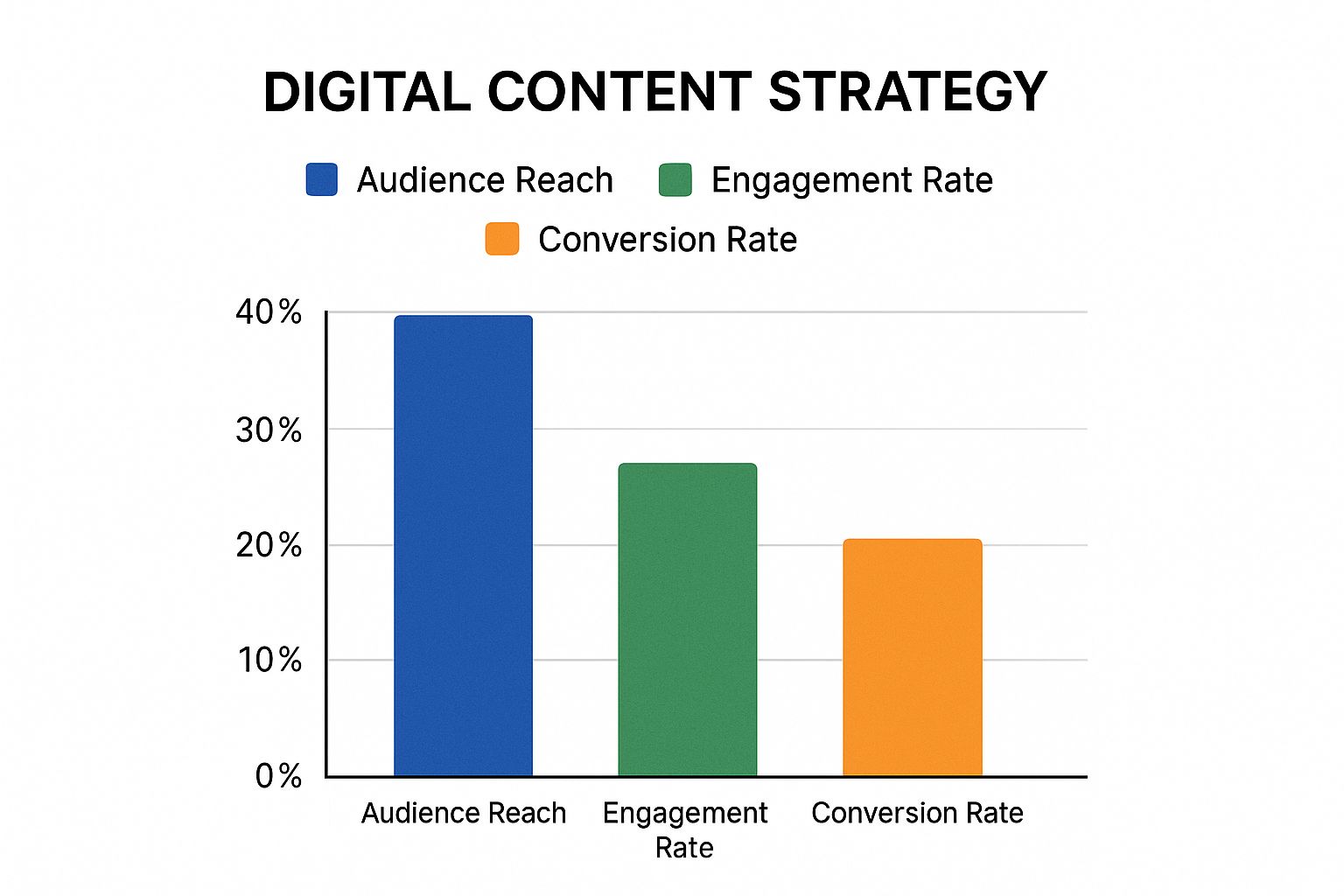Navigating Today's Digital Content Landscape

The digital content world is constantly changing. This requires a dynamic digital content strategy to keep up. Old marketing plans are becoming less effective as audiences and online platforms evolve. This means moving away from rigid, one-size-fits-all approaches and towards flexible, data-driven strategies. Businesses must adapt their content to stay ahead of the curve. This section explores how.
Understanding the Shift
Several factors are changing how we create content. These include the rise of short-form video, the importance of personalized content, and the growing influence of AI. Platforms like TikTok and Instagram Reels prioritize short, engaging videos, changing how businesses connect with their audience.
Data analytics allows for highly personalized content. This caters to individual user preferences and increases engagement. This shift from general messaging to targeted communication requires a new way of thinking about how we create and share content.
Content marketing revenue is expected to reach $107.5 billion globally by 2026. 49% of marketers now use video as a primary tool. This highlights the increasing importance of data-driven strategies. AI-powered analytics help optimize content performance and audience targeting. For a deeper dive into these statistics, check out Digital Silk's Content Marketing Statistics. Businesses need a strong digital content strategy to succeed in this growing market.
Key Components of a Modern Digital Content Strategy
A successful digital content strategy needs several key elements:
- Data-Driven Insights: Analyzing user behavior, platform trends, and content performance is crucial for smart decisions.
- Platform Optimization: Tailoring content for each platform maximizes visibility and engagement.
- Content Repurposing: Adapting existing content for different formats and platforms gets more mileage from your work. This could be turning a blog post into a video or infographic.
- Agile Adaptation: Staying flexible and adapting to changes in the digital landscape is key for long-term success. This includes using new platforms and technologies.
Visualizing the Data
The following data chart visualizes the projected growth of content formats over the next two years, demonstrating the growing importance of video:
| Content Format | 2025 (Projected) | 2026 (Projected) |
|---|---|---|
| Video | 60% | 75% |
| Blog Posts | 25% | 15% |
| Infographics | 10% | 5% |
| Other | 5% | 5% |
This chart clearly shows video content is growing rapidly. Other formats are growing more slowly or even declining. This emphasizes the importance of video in any digital content strategy. Video is highly effective at grabbing attention and driving engagement. This reinforces the need for tools like Aeon, which helps publishers integrate video content.
To further illustrate how digital content strategy has changed, let's examine the following table:
Evolution of Digital Content Strategy
This table shows how digital content strategy has evolved, highlighting key shifts.
| Era | Primary Focus | Key Technologies | Success Metrics |
|---|---|---|---|
| Early 2000s | Website Traffic | SEO, Email Marketing | Page Views, Unique Visitors |
| Mid 2000s - 2010s | Content Creation & Distribution | Social Media, Blogging, Content Management Systems | Social Shares, Backlinks |
| Late 2010s - Present | Audience Engagement & Personalization | Mobile-First, Video, AI, Data Analytics | Engagement Rate, Conversion Rate, Customer Lifetime Value |
This table demonstrates a clear shift from simply driving traffic to focusing on engaging audiences and providing personalized experiences. As technology has advanced, so too have the metrics used to measure success.
Implementing Your Strategy With Aeon
Aeon helps publishers navigate the complexities of the digital content landscape by simplifying video production. Aeon's AI-driven features transform text and other content into engaging videos. This allows businesses to capitalize on the increasing demand for video content. By automating key processes, Aeon lets content creators focus on strategy and storytelling. Aeon ensures content reaches the right audience at the right time. This allows businesses to stay agile and effective without being overwhelmed.
Crafting a Video-First Digital Content Strategy

Video has become an indispensable part of any successful digital content strategy. It’s not just a passing trend; it’s a core component of how audiences consume information and how businesses connect with them. This section explores building a robust video strategy that delivers tangible results.
Aligning Video Formats With Business Objectives
Different video formats achieve different goals. A short, captivating video on Instagram Reels might be ideal for boosting brand visibility. On the other hand, a detailed product tutorial on YouTube could significantly increase sales. A clear digital content strategy is essential to leverage these differences.
-
Short-Form Video: Perfect for grabbing attention on platforms like TikTok and Instagram. These videos should be concise, visually engaging, and designed for mobile viewing.
-
Long-Form Video: Provides deep dives, tutorials, and insightful content on platforms like YouTube and in webinars.
-
Live Video: Fosters real-time interaction with your audience, creating a sense of community. Live Q&A sessions, behind-the-scenes looks, and product launches are all excellent uses of live video.
-
Animated Explainer Videos: Break down complex ideas and present information clearly and engagingly. These are particularly helpful for explaining software products or services.
Building Scalable Video Production Workflows
Consistent, high-quality video content requires streamlined production. This involves establishing a clear process for each stage:
-
Ideation: Generating and developing video concepts aligned with your overall digital content strategy.
-
Scripting and Storyboarding: Planning the narrative and visuals of your videos to maximize clarity and engagement.
-
Filming and Editing: Bringing your vision to life with professional filming and editing techniques.
-
Distribution and Promotion: Sharing your videos on the appropriate platforms and promoting them to your target audience.
Maintaining brand consistency throughout this process is paramount. This ensures that all your videos, regardless of format or platform, strengthen your brand identity.
Resource Allocation and Platform Optimization
Video production can demand significant resources. Balancing quality and efficiency is crucial for effective resource allocation. By 2025, video became a cornerstone of digital strategies, with 78% of consumers preferring short videos to learn about products and 93% of marketers prioritizing social media video platforms. For more insights, check out Deloitte's Digital Media Trends Report. This emphasizes the need for efficient production and effective resource management.
Optimizing videos for each platform is also essential. Consider factors like video length, aspect ratio, and captioning requirements to boost visibility and engagement. Each platform's unique characteristics play a significant role in a successful strategy.
Cross-Channel Narrative Cohesion
While platform-specific optimization is important, maintaining a unified narrative across all channels is equally vital. Your videos, whether on YouTube, Instagram, or your website, should convey a consistent story and reinforce your brand message. This cohesive approach strengthens brand identity and resonates with audiences across different platforms. You might find this article interesting: Transform Your Story With Text-to-Video Magic. This strengthens your brand and improves impact.
Building a Cross-Platform Content Distribution Engine

A robust digital content strategy needs more than just compelling content. It needs a powerful distribution engine. Simply publishing on multiple channels isn't enough. Leading brands are building integrated ecosystems. Content flows strategically between platforms within these ecosystems, maximizing impact and ROI. Let's explore how to build your own high-performance distribution system.
Prioritizing Platforms Strategically
Forget chasing the latest platform trends. Prioritize based on audience behavior. Where do your ideal clients spend their time online? Do they use LinkedIn for networking, Twitter for news, or Instagram for casual browsing? Understanding these nuances lets you focus your efforts and resources where they matter most. This targeted approach avoids wasted effort on platforms that won't connect with your key demographics.
Content Repurposing for Maximum Value
Effective distribution means squeezing the most value from your content. Content repurposing is the key. Think of your content as modular building blocks. A single insightful webinar, for example, can become multiple assets:
- Short, engaging video clips for social media
- Blog posts summarizing key takeaways
- Infographics visualizing data points
- Email newsletters promoting the full recording
This maximizes your reach and impact while minimizing production costs. Your core message resonates across platforms, tailored to each audience.
Balancing Paid and Organic Reach
A successful digital content strategy balances paid and organic reach. Paid promotion on platforms like LinkedIn and Twitter quickly expands your reach and targets specific demographics. Organic strategies, like SEO optimization and community building, are essential for long-term growth and credibility. Combining these approaches achieves both immediate visibility and sustained engagement.
In 2025, social media advertising spend reached $276.7 billion annually. Users averaged 6.83 social platforms monthly, highlighting the need for cross-channel strategies. More detailed statistics can be found in the Digital 2025 Global Overview Report. This underscores the importance of balancing paid and organic reach for a comprehensive digital content strategy.
Maintaining Narrative Consistency Across Channels
While adapting content for different platforms is crucial, maintaining a consistent narrative is paramount. Your brand message and core values must remain recognizable, regardless of the channel. This consistency builds trust and reinforces your brand identity. While your Instagram content might be visual and informal, it should still reflect the same expertise and professionalism as your LinkedIn posts. This balance strengthens your overall brand presence.
Building a Dynamic Content Ecosystem With Aeon
Aeon empowers publishers to build a robust, integrated content ecosystem. By automating video creation, Aeon frees your team to focus on strategy and distribution. You can efficiently create channel-specific videos while ensuring narrative consistency and maximizing impact. This allows you to stay ahead of the curve and effectively engage your audience on all platforms.
Harnessing Data and AI in Your Digital Content Strategy
Data and AI are essential tools for any modern digital content strategy. They allow you to go beyond surface-level metrics like page views and truly understand your audience. This data-driven approach empowers you to create content that resonates, leading to measurable results.
Building Content Operations Powered by Insights
Effective content strategies are built on data, not guesswork. Analyzing user behavior, engagement patterns, and content performance offers valuable insights. Track metrics like time on page, bounce rate, and conversion rate to refine your content and focus your efforts. This helps you identify what's working, what needs improvement, and where to concentrate your resources. Learn more about data-driven decision making: How to master data analytics for marketers and transform your strategy.
For example, a high bounce rate on a blog post may suggest that the content isn't what users anticipated or the title is unclear. Using this data, you can make informed decisions, such as rewriting the introduction, incorporating more visuals, or revising the title to better represent the content.
Implementing Content Experimentation Frameworks
Data analysis lays the foundation, but experimentation drives optimization. A/B testing, a method for comparing two versions of content, is a simple way to test different headlines, calls to action, or even entire page layouts. Multivariate testing allows for testing multiple variables concurrently, revealing complex interactions and optimizing for various objectives. This iterative process ensures continuous improvement.
Think of it like perfecting a recipe. A/B testing is like comparing two types of flour. Multivariate testing is like simultaneously tweaking ingredients and baking time for the ideal outcome.
Integrating AI Responsibly Throughout the Content Lifecycle
AI offers powerful capabilities throughout the content lifecycle. From AI-powered keyword research with tools like Semrush to content personalization and automated content creation with platforms like Jasper, AI tools are increasingly valuable. However, responsible usage is crucial. Brand integrity and authenticity should remain top priorities. While AI can assist, the human element of storytelling and creative direction is still essential.
Building Feedback Loops for Continuous Refinement
Successful digital content strategies prioritize continuous improvement. Establish feedback loops incorporating audience response and data analysis. Regularly review content performance, gather user feedback, and use these insights to refine your strategy. This iterative process ensures your content stays relevant, engaging, and effective. It’s a continuous dialogue with your audience, allowing you to adapt based on their preferences and needs.
Content Performance Metrics Framework
To effectively measure content performance, consider the following framework. This table outlines key metrics for various content types and business objectives, facilitating data collection and analysis.
Content Performance Metrics Framework: This table outlines the most important metrics to track for different types of content and business objectives, helping prioritize data collection and analysis.
| Content Type | Awareness Metrics | Engagement Metrics | Conversion Metrics | Retention Metrics |
|---|---|---|---|---|
| Blog Post | Page Views, Social Shares | Comments, Time on Page | Lead Magnet Downloads | Returning Visitors |
| Video | Views, Impressions | Likes, Shares, Comments | Click-Through Rate | Watch Time, Subscribers |
| Social Media Post | Reach, Impressions | Likes, Comments, Shares | Link Clicks | Followers, Repeat Engagement |
By tracking these metrics and analyzing the data, you can gain a deeper understanding of what resonates with your audience and how to improve your content strategy over time. This data-driven approach ensures that your content contributes to achieving your overall business objectives. Combined with consistent analysis and experimentation, this framework empowers a truly data-driven content strategy. By harnessing data and AI responsibly, you can ensure your content resonates, drives meaningful engagement, and delivers measurable business impact.
Balancing Automation and Authenticity in Content Creation

In the ever-growing world of digital content, automation is becoming increasingly important. However, maintaining authenticity within your digital content strategy remains crucial for success. While AI tools offer undeniable efficiency, brands that genuinely connect with their audience on a human level are the ones that truly stand out. This section explores the delicate balance between leveraging the power of automation and preserving the essential human element of storytelling.
Defining the Roles of Automation and Human Creativity
Automation truly shines when it comes to tasks like keyword research, content scheduling, and social media posting. These tools free up valuable time for human creators, allowing them to focus on more strategic aspects like strategy, storytelling, and relationship building. Think of automation as the engine of your content machine, while human creativity is the fuel and direction.
This collaborative approach maximizes efficiency without sacrificing the emotional resonance that deeply connects with audiences. A well-oiled machine needs both a powerful engine and skilled navigation.
For example, AI can easily generate numerous social media captions for a blog post. However, it takes a human writer to infuse those captions with nuance, personality, and a genuine connection that resonates with your target audience. This blend of efficiency and genuine human touch yields powerful results.
Governance Models For Quality Control at Scale
Scaling content creation often presents challenges in maintaining consistent quality. Establishing clear governance models is key. This involves defining roles and responsibilities, establishing content style guidelines, and implementing thorough review processes.
A robust governance model ensures that even automated content aligns with your brand's voice and maintains high quality. It's like a conductor leading an orchestra – each instrument plays its part, but the conductor ensures harmony and a unified sound.
Ethical Guidelines For AI-Assisted Content
As AI takes on a larger role in content creation, ethical considerations become paramount. Transparency with your audience about the use of AI is essential. Make sure AI-generated content aligns with your brand values and avoids perpetuating harmful biases.
Maintaining human oversight is crucial. This ensures accuracy, prevents the spread of misinformation, and guarantees ethical standards are consistently met. This ethical approach fosters trust and strengthens your brand credibility.
Preserving Brand Voice Across Automated Channels
Consistency is key to building a strong brand identity. Maintaining a unified brand voice across all channels, including those driven by automation, can be tricky. Develop clear brand voice guidelines that inform both human creators and AI tools. This includes aspects like tone, language, and overall style.
Regular audits of your automated content can help ensure consistent brand representation across all platforms. Think of your brand voice as a fingerprint – unique and recognizable, no matter the medium.
Enhancing Storytelling With Technology
Leading brands aren't replacing storytelling with technology; they are using technology to enhance it. Aeon, for example, automates time-consuming aspects of video creation, allowing publishers to focus on narrative and audience engagement. This approach empowers creators to develop more compelling stories, explore new formats, and build deeper connections with their audience.
A balanced approach to automation and authenticity combines the efficiency of technology with the human touch that fosters genuine connection. By embracing this balance, your digital content strategy can achieve both scale and resonance, driving meaningful results. This balance is the key to the future of effective content creation.
Measuring the True ROI of Your Digital Content Strategy
Want to truly understand the impact of your digital content? It's time to look beyond vanity metrics like page views and social shares. True return on investment (ROI) measurement connects your content directly to tangible business results. This means understanding how your content influences every step of the customer journey, from the moment they discover your brand to the final purchase.
Beyond Vanity Metrics: Focusing on Business Impact
Surface-level metrics offer a glimpse into content performance, but they don't tell the whole story. A large number of page views is meaningless if those views don't translate into meaningful actions. Instead, concentrate on metrics aligned with your specific business objectives.
What are you trying to achieve? Is it lead generation, sales conversions, increased customer lifetime value, or perhaps brand awareness (measured by quantifiable increases in brand searches)? Focusing on these outcomes will help you measure what truly matters.
This strategic approach requires understanding the role of content in the customer journey. A blog post might initially attract a prospect. A case study could build credibility. A product demo video might encourage a purchase. By tracking these interactions, you can measure the real impact of each piece of content.
Attribution Models: Connecting Content to Conversions
Attribution modeling is crucial for understanding the complex relationship between content and conversions. Different models assign credit to different touchpoints in the customer journey. A last-click attribution model credits the final interaction before conversion. A multi-touch attribution model distributes credit across multiple touchpoints.
For example, imagine a customer finds your brand through a blog post, downloads a white paper, attends a webinar, and then makes a purchase. A multi-touch model recognizes the contribution of each piece of content, offering a more complete picture of the customer journey. You might find this resource helpful: How to master video content strategy for real ROI.
Content Audits: Identifying Optimization Opportunities
Regular content audits are vital for maximizing your ROI. A content audit involves systematically reviewing your existing content. The goal is to identify high-performing assets, uncover gaps, and find opportunities for improvement. This might involve analyzing content performance metrics, checking keyword rankings, and gathering user feedback.
Content audits reveal which pieces are driving valuable actions like leads or sales. They also identify outdated or underperforming content that needs refreshing or removal. This allows you to focus your strategy on what works and eliminate what doesn't.
Building Effective Dashboards for Different Stakeholders
Communicating the value of your content strategy requires tailored dashboards. Content teams need metrics like engagement and conversion rates to optimize their daily work. Executives are more interested in strategic outcomes like revenue growth and customer acquisition cost.
Customized dashboards ensure everyone has the information they need to make informed decisions. This promotes clear communication and aligns content efforts with broader business goals.
Aligning KPIs With Business Objectives
Effective ROI measurement depends on aligning key performance indicators (KPIs) with overarching business goals. If your goal is brand awareness, your KPIs might include website traffic, social media reach, and brand mentions. If your objective is lead generation, your KPIs should focus on conversion rates, lead quality, and cost per lead.
This alignment ensures your content efforts directly contribute to desired business outcomes. By tracking the right metrics, you can demonstrate the real value of your digital content strategy and gain support from key stakeholders. A well-defined digital content strategy guides your efforts towards measurable business results. Through careful measurement, you can prove the power of content as a driver of growth and establish its vital role in your overall marketing strategy.
Future-Proofing Your Digital Content Strategy
The online world is constantly changing. What's effective today might not be tomorrow. This means your digital content strategy needs to be flexible, able to adapt to new trends and technologies. This section explores how forward-thinking brands build resilient, future-proof strategies.
Embracing Experimentation and Innovation
A key to future-proofing is experimentation. Think of your content strategy as a living document, constantly being updated. This requires a willingness to try new platforms and ideas. Establish a framework for experimental content initiatives. This might involve testing new video formats like those available on Vimeo, exploring new social media, or experimenting with AI-powered content creation tools like Aeon.
These experiments should be measured and analyzed. Successful strategies are expanded upon. Those that don't work are refined or abandoned. This iterative approach helps you stay ahead of the curve and spot future opportunities.
Balancing Innovation With Consistent Execution
While experimentation is crucial, don't abandon the core elements that are already driving results. Find a balance between innovation and consistent execution. Your core digital content strategy provides a solid base. Experimental initiatives build upon this base, exploring new avenues for growth.
This balanced approach ensures you maintain a regular flow of content while exploring innovative approaches. It's like building a house: you need a strong foundation before you can add new rooms.
Building Adaptive Content Systems
Your content systems themselves need to be adaptable. This means using technology that can evolve with your needs. Consider a headless CMS like Contentful or other flexible systems that allow you to easily repurpose content for different platforms. This flexibility enables you to adapt as platforms and user behaviors change.
Think of it like building with blocks. A rigid structure is difficult to change. But modular blocks can be rearranged to create something new. Adaptive content systems give you that same flexibility.
Maintaining Audience Relationships Through Change
Change can be disruptive, even when it's positive. Maintaining strong audience relationships during times of change requires clear communication and a focus on value. Keep your audience informed about changes to your digital content strategy. Explain the rationale behind changes and how those changes will benefit them.
For example, if you're moving towards more video content, explain why. Perhaps video allows for a stronger connection or provides more engaging content. This transparency builds trust and strengthens audience relationships.
Learning From Brands That Have Navigated Disruption
Study how successful brands have navigated significant changes in the online world. Which strategies did they use? What lessons can be learned from their experiences? Case studies provide valuable insight and can inform your approach to future-proofing.
Consider brands that have successfully adapted to major platform shifts or new technologies. How did they maintain their audience during these transitions? Their experiences offer valuable lessons for your own strategy.
Want to future-proof your content strategy and harness the potential of video? Aeon empowers publishers to create engaging video content efficiently, allowing your team to focus on strategy and innovation. Turn text and other content into high-quality videos that captivate your audience and deliver results. Explore Aeon today.